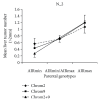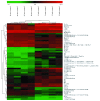Genetic Predisposition to Hepatocarcinogenesis in Inbred and Outbred Mouse Lines Selected for High or Low Inflammatory Response
- PMID: 31049358
- PMCID: PMC6462334
- DOI: 10.1155/2019/5298792
Genetic Predisposition to Hepatocarcinogenesis in Inbred and Outbred Mouse Lines Selected for High or Low Inflammatory Response
Abstract
AIRmax and AIRmin mouse strains phenotypically selected for high and low acute inflammatory responsiveness (AIR) are, respectively, susceptible or resistant to developing hepatocellular carcinoma (HCC) induced by the chemical carcinogens urethane and diethylnitrosamine (DEN). Early production of TNF-α, IL-1β, and IL-6 in the liver after DEN treatment correlated with tumor development in AIRmax mice. Transcriptome analysis of livers from untreated AIRmax and AIRmin mice showed specific gene expression profiles in each line, which might play a role in their differential susceptibility to HCC. Linkage analysis with SNP markers in F2 (AIRmax×AIRmin) intercross mice revealed two quantitative trait loci (QTL) in chromosomes 2 and 9, which are significantly associated with the number and progression of urethane-induced liver tumors. An independent linkage analysis with an intercross population from A/J and C57BL/6J inbred mice mapped regions in chromosomes 1 and 7 associated with the progression of urethane-induced liver tumors, evidencing the heterogeneity of HCC genetic control.
Figures







References
-
- Montalto G., Cervello M., Giannitrapani L., Dantona F., Terranova A., Castagnetta L. A. Epidemiology, risk factors, and natural history of hepatocellular carcinoma. Annals of the New York Academy of Sciences. 2002;963:13–20. - PubMed
MeSH terms
Substances
LinkOut - more resources
Full Text Sources
Medical
Molecular Biology Databases
Miscellaneous

